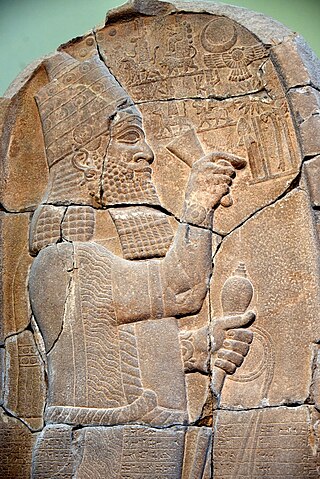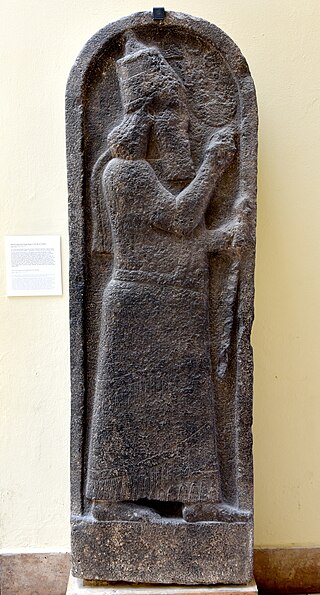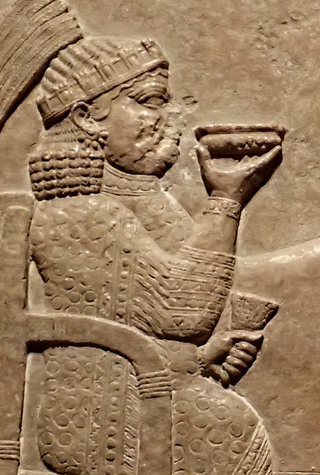Luli or Elulaios was king of the Phoenician city of Tyre. During his reign, Tyre lost what remained of its power to Assyria.

Esarhaddon, also spelled Essarhaddon, Assarhaddon and Ashurhaddon was the king of the Neo-Assyrian Empire from the death of his father Sennacherib in 681 BC to his own death in 669. The third king of the Sargonid dynasty, Esarhaddon is most famous for his conquest of Egypt in 671 BC, which made his empire the largest the world had ever seen, and for his reconstruction of Babylon, which had been destroyed by his father.

Šamaš-šuma-ukin, was king of Babylon as a vassal of the Neo-Assyrian Empire from 668 BC to his death in 648. Born into the Assyrian royal family, Šamaš-šuma-ukin was the son of the Neo-Assyrian king Esarhaddon and the elder brother of Esarhaddon's successor Ashurbanipal.

Baal I was a king of Tyre. His name is the same as that of the Phoenician deity, Baal. He was tributary to the Assyrians, who had conquered the rest of Phoenicia.

Idalion or Idalium was an ancient city in Cyprus, in modern Dali, Nicosia District. The city was founded on the copper trade in the 3rd millennium BC. Its name does not appear, however, on the renowned "Kition Stele", i.e., the Sargon Stele of 707 BC, but a little later on the Prism of Esarhaddon known as Niniveh A wherein the name is prefixed by the modifier URU (city) as URU.e-di-ʾi-il and in similar spellings in Ashurbanipal's annal while modified by KUR (land/kingdom).
Aššūr-nādin-apli, inscribed maš-šur-SUM-DUMU.UŠ, was king of Assyria. The alternate dating is due to uncertainty over the length of reign of a later monarch, Ninurta-apal-Ekur, where conflicting king lists differ by ten years. His name meant "Aššur is the giver of an heir" in the Akkadian language. He was a son of Tukulti-Ninurta I.

Baalshamin, also called Baal Shamem and Baal Shamaim, was a Northwest Semitic god and a title applied to different gods at different places or times in ancient Middle Eastern inscriptions, especially in Canaan/Phoenicia and Syria. The title was most often applied to Hadad, who is also often titled just Ba‘al. Baalshamin was one of the two supreme gods and the sky god of pre-Islamic Palmyra in ancient Syria. There his attributes were the eagle and the lightning bolt, and he perhaps formed a triad with the lunar god Aglibol and the sun god Malakbel. The title was also applied to Zeus.

The Victory stele of Esarhaddon is a dolerite stele commemorating the return of Esarhaddon after his army's 2nd battle and victory over Pharaoh Taharqa in northern ancient Egypt in 671 BC. It was discovered in 1888 in Zincirli Höyük by Felix von Luschan and Robert Koldewey. It is now in the Pergamon Museum in Berlin.
Burna-Buriyåš I, meaning servant of the Lord of the lands, was the first Kassite who really ruled over Babylonia, possibly the first to occupy the city of Babylon proper around 1500 BC, culminating a century of creeping encroachment by the Kassite tribes. He was the 10th king of this dynasty to be listed on the Assyrian Synchronistic Kinglist.
Adad-apla-iddina, typically inscribed in cuneiform mdIM-DUMU.UŠ-SUM-na, mdIM-A-SUM-na or dIM-ap-lam-i-din-[nam] meaning the storm god “Adad has given me an heir”, was the 8th king of the 2nd Dynasty of Isin and the 4th Dynasty of Babylon and ruled c. 1064–1043. He was a contemporary of the Assyrian King Aššur-bêl-kala and his reign was a golden age for scholarship.

Chronicle P, known as Chronicle 22 in Grayson’s Assyrian and Babylonian Chronicles and Mesopotamian Chronicle 45: "Chronicle of the Kassite Kings" in Glassner's Mesopotamian Chronicles is named for T. G. Pinches, the first editor of the text. It is a chronicle of the second half of the second millennium BC or the Kassite period, written by a first millennium BC Babylonian scribe.

The Sargon Stele was found in the autumn of 1845 in Cyprus on the site of the former city-kingdom of Kition, in present-day Larnaca to the west of the old harbour of Kition on the archaeological site of Bamboula. The language on the stele is Assyrian Akkadian.

Naqiʾa or Naqia (Akkadian: Naqīʾa, also known as Zakūtu, was a wife of the Assyrian king Sennacherib and the mother of his son and successor Esarhaddon. Naqiʾa is the best documented woman in the history of the Neo-Assyrian Empire and she reached an unprecedented level of prominence and public visibility; she was perhaps the most influential woman in Assyrian history. She is one of the few ancient Assyrian women to be depicted in artwork, to commission her own building projects, and to be granted laudatory epithets in letters by courtiers. She is also the only known ancient Assyrian figure other than kings to write and issue a treaty.

The Azekah Inscription, is a tablet inscription of the reign of Sennacherib discovered in the mid-nineteenth century in the Library of Ashurbanipal. It was identified as a single tablet by Nadav Na'aman in 1974.
Kashtariti was a Median chieftain. He is mentioned as "King of the Medes" in an inscription dated 678 BCE. His lands were presumably located along the northeastern border of Assyria. Amongst his possessions was the city of Karkašši. Kashtariti forged an alliance of the Medes with the Cimmerians, Mannaeans, and Scythians against Assyria.

The Sargonid dynasty was the final ruling dynasty of Assyria, ruling as kings of Assyria during the Neo-Assyrian Empire for just over a century from the ascent of Sargon II in 722 BC to the fall of Assyria in 609 BC. Although Assyria would ultimately fall during their rule, the Sargonid dynasty ruled the country during the apex of its power and Sargon II's three immediate successors Sennacherib, Esarhaddon and Ashurbanipal are generally regarded as three of the greatest Assyrian monarchs. Though the dynasty encompasses seven Assyrian kings, two vassal kings in Babylonia and numerous princes and princesses, the term Sargonids is sometimes used solely for Sennacherib, Esarhaddon and Ashurbanipal.

Šērūʾa-ēṭirat, called Saritrah in later Aramaic texts), was an ancient Assyrian princess of the Sargonid dynasty, the eldest daughter of Esarhaddon and the older sister of his son and successor Ashurbanipal. She is the only one of Esarhaddon's daughters to be known by name and inscriptions listing the royal children suggest that she outranked several of her brothers, such as her younger brother Aššur-mukin-paleʾa, but ranked below the crown princes Ashurbanipal and Shamash-shum-ukin. Her importance could be explained by her possibly being the oldest of all Esarhaddon's children.

Libbāli-šarrat was a queen of the Neo-Assyrian Empire as the primary consort of Ashurbanipal. Libbāli-šarrat married Ashurbanipal before he became king, probably in 672 BC, and may have lived beyond her husband's death, as documents from the reign of her probable son, Ashur-etil-ilani reference the "mother of the king". Libbāli-šarrat enjoys the distinction of being the only known individual from ancient Assyria who was not a king to be depicted holding court since she is depicted in one of Ashurbanipal's reliefs as hosting him at dinner in the palace garden, surrounded by her own female servants.
The Kings of Byblos were the rulers of Byblos, the ancient Phoenician city in what is now Lebanon.

The Rassam cylinder is a cuneiform cylinder, forming a prism with ten faces, written by Neo-Assyrian king Ashurbanipal in 643 BCE. The 7th century BCE cylinder was discovered in the North Palace of Nineveh by Hormuzd Rassam in 1854, hence its name. It is located in the British Museum.














